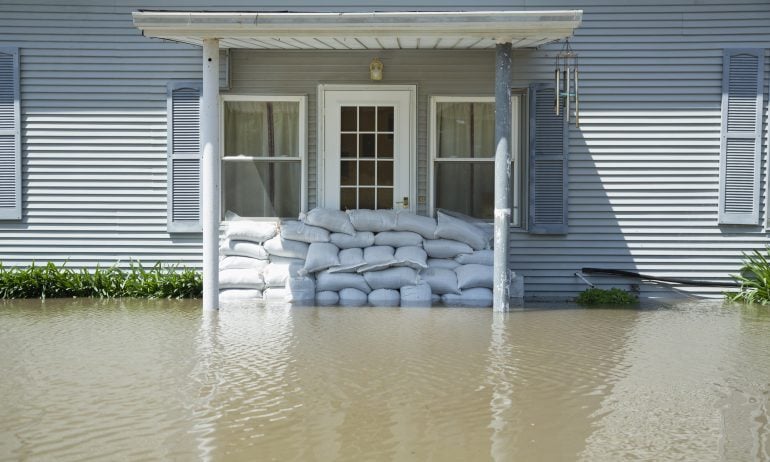How to Choose the Best Flood Insurance
Here’s how to decide between private flood insurance and coverage offered by the National Flood Insurance Program.

Many, or all, of the products featured on this page are from our advertising partners who compensate us when you take certain actions on our website or click to take an action on their website. However, this does not influence our evaluations. Our opinions are our own. Here is a list of our partners and here's how we make money.
Most people buy flood insurance through the National Flood Insurance Program, sold by FEMA-approved flood insurance providers like Allstate and Liberty Mutual.
The NFIP’s policies may not be the best flood insurance for you if you need higher limits or broader coverage.
Private flood insurance companies like Neptune Flood and Aon Edge often offer more comprehensive coverage.
You’re ready to buy flood insurance — but where should you begin? You could turn to one of the many flood insurance companies selling policies from the National Flood Insurance Program. However, private flood insurance, from providers unaffiliated with the NFIP, might be a better option. Here’s how to find the best flood insurance for your home in four steps.
Check what’s available
The most common source of flood insurance is the National Flood Insurance Program, part of the Federal Emergency Management Agency. The NFIP partners with dozens of FEMA-approved insurance providers, including several of the nation’s largest insurers, to sell and manage its standard policy.
You’re eligible for NFIP coverage as long as you live in one of the program’s roughly 23,000 participating communities.
You may also have the option to buy private flood insurance instead of going the federal route. (A note about terminology: NFIP policies are technically sold by companies such as Farmers and USAA, but by "private flood insurance," we mean policies that aren’t underwritten by the federal government or bound by its requirements.)
An independent agent or broker can help you find alternatives to the NFIP in your area.
Determine your coverage needs
Several factors will determine how much flood insurance you should purchase and where you should buy it.
Mortgage lender’s requirements
If you’re getting flood insurance as a condition of a mortgage, make sure you know how much coverage your lender requires. For example, you may need enough flood insurance to cover the outstanding balance on the loan.
Keep in mind that the amount your lender requires may not necessarily be enough coverage to protect you financially. Your bank might mandate insurance only for the structure of your home, not your belongings — but if a flood damaged all your furniture, could you afford to replace it? If not, you might want to buy flood insurance for your belongings (sometimes called “personal property” or “contents”).
Before purchasing private flood insurance, check with your mortgage lender to make sure the policy will satisfy its requirements.
Coverage limits
The NFIP's maximum coverage limits are $250,000 for your home and $100,000 for your belongings. If you have a large home, these limits might not be high enough to rebuild the house or replace damaged belongings after a major flood.
A type of supplemental policy known as excess flood insurance is one way to bridge the gap. Although excess flood insurance is compatible with NFIP plans, you must buy it separately from companies such as Wright Flood, Chubb or Aon Edge. An independent insurance agent can help you find reputable sellers in your area.
Alternatively, you may want to look into private flood insurance, which often has higher coverage limits than the NFIP.
What coverage you need
The standard NFIP policy has a few major exclusions. For instance, it won’t pay if you need to stay in a hotel while your home is being repaired after a flood. Got a deck or pool? The NFIP won't cover those either.
Here’s a quick summary:
What NFIP insurance covers | What NFIP insurance doesn't cover |
|---|---|
Damage to your home's structure, including the foundation and electrical and plumbing systems. | Damage to outdoor property, such as fences, patios and pools. |
Damaged belongings, such as clothing, electronics, appliances and furniture. | Additional living expenses, such as meals and hotels, if you have to leave home while it's being repaired. |
Debris removal. | Damage to vehicles. |
Artwork, furs and other valuables up to $2,500. | Improvements you’ve made to your basement, like carpeting and finished walls. Belongings stored in the basement. |
Private flood insurers may offer coverage for some of the things the NFIP excludes.
Shop around
If both options are available to you, try to get quotes from both the NFIP and private insurers. (An agent or broker can help.) Note that all of the NFIP’s partner companies offer the same flood insurance coverage and maximum payouts, so you don’t need to shop around with multiple FEMA-approved providers.
Try to look at policies with similar coverage limits and deductibles to ensure the fairest rate comparison. That said, a more expensive private flood insurance policy that offers higher limits or broader coverage may be worth it to you.
Raising your deductible — the amount of a claim you pay yourself — is one way to lower your annual premium. However, flood insurance policies often have separate deductibles for damage to the building and damage to your belongings, so the amount you’re responsible for can add up fast.
Not sure whether NFIP or private insurance is right for you? Here’s a breakdown to help you choose the best flood insurance.
Policy features | Private flood insurance companies | NFIP |
|---|---|---|
Max waiting period | 10-15 days, depending on the company. | 30 days. |
Coverage limits | Up to $15 million, depending on the company. | $250,000 for your home and $100,000 for your possessions. |
State availability | Nationwide, depending on the company. | Nationwide in roughly 23,000 participating communities. |
Basement contents | May be covered. | Generally not covered. |
Choose the best flood insurance company
Once you’ve opted for an NFIP policy or a private insurer, here’s how to choose where to buy your policy.
NFIP
Although there’s generally no price variation among the NFIP’s partner companies, it’s wise to buy your policy through an insurer with a strong reputation for consumer satisfaction. Below are companies that NerdWallet has rated at least 4 out of 5 stars and that offer NFIP policies.
Company | NerdWallet rating |
|---|---|
USAA* | |
*USAA policies are available only to active military, veterans and their families. | |
You can also ask your existing insurer if it sells flood insurance. Buying all your policies from one company may be the most convenient option.
You can find a full list of NFIP flood insurance providers in your state on FloodSmart.gov.
» MORE: Flood insurance for renters
Private flood insurance
You may want to use a little more caution when choosing a private flood insurance company. Unlike NFIP coverage, which has U.S. government backing, private flood policies are issued by companies that could potentially go out of business. You’ll want to do some homework to make sure the company you choose will be around if you need it.
Some private flood insurers are surplus lines carriers, which means they cover risks standard insurers won’t. They don't have to contribute to a state’s guaranty fund, which pays policyholders’ claims if a standard company goes out of business. So if a massive storm hits your region and your surplus lines carrier can’t afford to settle its claims, you may not get the payout you were expecting.
That said, state and other regulatory agencies oversee surplus lines carriers and the brokers who sell their policies, so the industry isn't a free-for-all. Surplus lines carriers generally don’t go out of business very often, according to the National Association of Insurance Commissioners.
You can check a company’s financial strength on sites like AM Best and S&P Global. (You may need to register for free to see the ratings.) You can also search for reviews and news articles about a company to get a sense of other people’s experiences. Learn more about private flood insurance.

